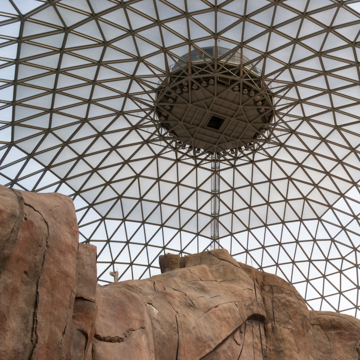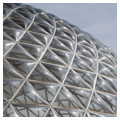The Desert Dome is set adjacent to the entry gates of the Henry Doorly Zoo on the south side of the city of Omaha. Formerly Riverview Park Zoo, the zoo was renamed by donor Margaret Hitchcock Doorly in honor of her late husband, Henry Doorly, who was the long-standing chairman of the World Publishing Company in the city.
The structure, a geodesic dome 160 feet in diameter and 137 feet tall, shows the influences of Buckminster Fuller’s principles. Composed of 1,760 quarter-inch-thick, acrylic, triangular-shaped panels, the glazed dome is anchored on a 32-foot reinforced concrete ring wall clad in stone. The slabs and ring wall are made of 10,000 tons of concrete and 250 tons of reinforcing steel. Inside the dome, more than 2,000 linear feet of masonry walls enclose animal exhibits, keeper rooms, and holding areas. Other masonry block walls are used to support the irregular walls that form the exhibition’s naturalistic rockwork. Construction of the geodesic dome began in October 1999 and it opened to the public in March 2002.
The 13-story dome is currently the world’s largest indoor desert exhibit at nearly 84,000 square feet spread over two levels. The interior replicates environments of the Namib Desert in western Africa, the Great Sandy Desert in Australia, and the Sonoran Desert in the southwestern United States. It includes a sand waterfall, a 50-foot mountain, canyons, a cactus forest, desert flora and fauna, and various animal exhibits. The subterranean level showcases spaces for indoor nocturnal exhibitions.





















